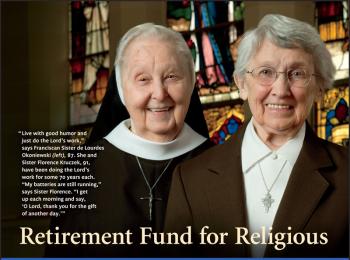The annual Retirement Fund for Religious collection will be held the weekend of Dec. 7-8 in the Diocese of Allentown.
The parish-based appeal is coordinated by the National Religious Retirement Office (NRRO), and proceeds help hundreds of U.S. religious communities care for aging members. Some 30,000 senior Catholic sisters, brothers and religious order priests benefit.
Last year the Diocese of Allentown donated $26,984.57 to the collection.
In 2019, the Bernardine Franciscan Sisters, Cistercian Fathers, Missionary Sisters of the Most Sacred Heart and the Missionary Sisters of the Precious Blood received a combined total of $318,680.22 in financial support made possible by the Retirement Fund for Religious.
Additionally, the Diocese of Allentown, in conjunction with the Archdiocese of Philadelphia and the Diocese of Harrisburg, also distributes funding to local religious communities to support retirement needs.
This year’s national Retirement Fund for Religious campaign features two members of the Bernardine Franciscans: Sister de Lourdes Okoniewski and Sister Florence Kruczek. Both have been members of the congregation for roughly 70 years.
The 2018 appeal raised $27.7 million, and 360 religious congregations across the nation received funding. Distributions are sent to each eligible congregation’s central house. Communities combine this assistance with their own income and savings, and apply it toward various retirement expenses.
“We are humbled and profoundly grateful for the countless Catholics who honor the service and witness of senior religious through their prayers and generosity,” said Presentation Sister Stephanie Still, the NRRO’s executive director.
Catholic bishops of the United States initiated the Retirement Fund for Religious in 1988 to help address the profound lack of retirement savings among U.S. religious communities. Since the collection’s launch, U.S. Catholics have donated $872 million to the annual appeal.
Despite this generosity, many congregations still struggle to provide for aging members. Most older religious served for low wages that did not include retirement benefits.
Today numerous communities face a critical shortage in retirement savings. Moreover, retired religious now outnumber wage-earning members, resulting in declining income and a rising cost of care.
Proceeds from the annual collection allow NRRO to offer assessment tools, educational programming, services and resources that enable communities to evaluate and prepare for long-term retirement needs.
NRRO also coordinates an extensive network of volunteer consultants, including experts in eldercare and financial planning, to help congregations lower costs while enhancing care.
“Donations to the Retirement Fund for Religious enable our office to provide financial assistance for an array of direct needs,” said Sister Still. “They also underwrite education and resources that help religious communities stretch retirement dollars and plan for the future.”
Visit retiredreligious.org to learn more.
About the Retirement Fund for Religious
Why We Ask
In 1988, Catholic bishops of the United States launched the Retirement Fund for Religious (RFR) to address the significant lack of retirement funding for Catholic sisters, brothers, and priests in religious orders.
- For most of their lives, elder religious worked for little to no pay. There were no 401(k) plans or pensions.
- Religious communities are financially responsible for the support and care of all members. Income, earnings and expenses are managed separately from the parish and diocesan structures of the Catholic Church.
- The funding shortage is compounded by rising health care costs and decreased income. And, as more religious reach retirement age and leave compensated ministry, income will further decline while care needs increase.
- By 2029, religious past age 70 are projected to outnumber religious under age 70 by more than three to one.
- There are 30,151 religious past age 70 living in the United States. In 2018, the average annual cost for their care was roughly $47,000 per person; skilled care averaged $69,000 per person.
- Since 2009, the annual cost to support senior women and men religious has exceeded $1 billion.
- In 2018, 72 percent of the religious communities providing data to the National Religious Retirement Office (NRRO) had a median age of 70 or higher.
- The average annual Social Security benefit for a religious is $6,596.77, while the average U.S. beneficiary receives $17,535.72.
How Donations Help
- Each year, hundreds of U.S. religious communities receive financial assistance made possible by the Retirement Fund for Religious. Communities can use this funding for immediate retirement expenses or invest for future needs. Since the first collection, U.S. Catholics have donated $872 million.
- Since 1989, almost $737 million has been distributed to support the day-to-day care of elderly sisters, brother, and religious order priests. An additional $98 million has been allocated toward self-help projects initiated by religious communities, including collaborative health care facilities.
- In addition to direct financial assistance, proceeds from the annual appeal underwrite educational programming, services and resources that enable religious communities to evaluate and prepare for long-term retirement needs.
- Support from the Retirement Fund for Religious helps religious communities care for senior members while continuing important ministries to the People of God








